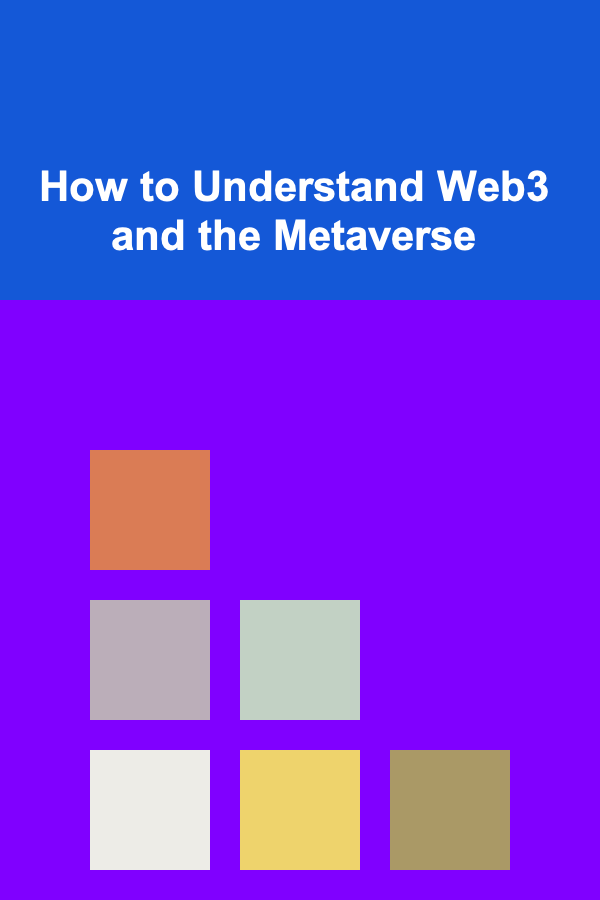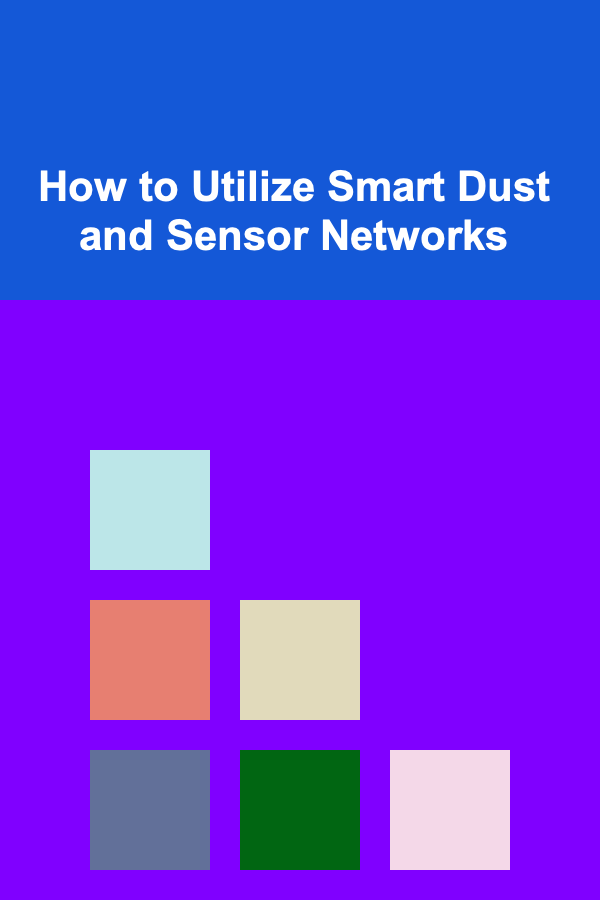
How to Understand Web3 and the Metaverse
ebook include PDF & Audio bundle (Micro Guide)
$12.99$11.99
Limited Time Offer! Order within the next:

In the digital era, technology has been evolving at an unprecedented rate, shaping the way we live, work, and interact. Two major concepts that have been gaining significant attention are Web3 and the Metaverse. While they are often discussed together, they represent distinct ideas, both of which have the potential to revolutionize the internet as we know it. This article will explore what Web3 and the Metaverse are, how they interconnect, and their implications for the future.
What is Web3?
Web3, often referred to as the decentralized web, is the next generation of the internet. It represents a shift away from the centralized systems that dominate the current web, Web2. To understand Web3, it's important to first grasp the key characteristics of Web2 and how Web3 differs from it.
From Web2 to Web3: A Shift in Control
Web2, the version of the internet most people are familiar with, is built around platforms controlled by large corporations like Google, Facebook, and Amazon. These companies own vast amounts of user data and have significant control over the flow of information. While Web2 has made the internet more interactive and user-friendly, it has also led to issues such as privacy concerns, centralized power, and the monopolization of data.
Web3 aims to change this dynamic by decentralizing control. In Web3, the idea is that no single entity should have full control over the web's infrastructure or user data. Instead, Web3 is built on blockchain technology, which allows for decentralized applications (dApps) and services. This means that ownership and control are distributed across a network of participants, rather than being concentrated in the hands of a few large corporations.
Key Features of Web3
- Decentralization: The primary principle of Web3 is decentralization. Blockchain technology, which underpins Web3, is a decentralized ledger that records transactions across many computers. This ensures that no single party controls the entire system.
- Ownership and Privacy: In Web3, users have more control over their data. Instead of relying on companies to store and manage personal information, users can own their data through decentralized identity systems. This means that users can choose when, how, and with whom they share their data.
- Smart Contracts: Smart contracts are self-executing contracts with the terms directly written into code. These contracts are stored on the blockchain and automatically enforce the terms of the agreement. This removes the need for intermediaries, making transactions more secure and transparent.
- Tokenization and Cryptocurrencies: Web3 is deeply intertwined with cryptocurrencies and digital tokens. Tokens are used to represent ownership, access rights, or value within decentralized applications. Cryptocurrencies like Bitcoin and Ethereum are the most well-known examples, but they are just the beginning. Web3 enables the creation of various types of tokens, such as non-fungible tokens (NFTs), which can represent unique assets like digital art or collectibles.
- Interoperability: Web3 aims for a more interconnected and seamless internet experience. Through decentralized networks, applications built on Web3 can interact with one another without relying on a central authority. This fosters innovation and collaboration, creating a more open and integrated ecosystem.
The Challenges of Web3
Despite its promising potential, Web3 is not without its challenges. These challenges include scalability issues, high energy consumption, regulatory uncertainty, and the need for user education. While blockchain technology has made significant progress, it still faces technical limitations that must be addressed before Web3 can achieve mainstream adoption.
What is the Metaverse?
The Metaverse is another concept that has been generating a lot of buzz in recent years. While Web3 focuses on decentralizing the internet, the Metaverse is envisioned as an immersive, digital universe where users can interact with each other and digital environments in real-time. The term "Metaverse" was first coined by Neal Stephenson in his 1992 science fiction novel Snow Crash, where it referred to a virtual reality-based successor to the internet. Today, the term has evolved to encompass a broad range of digital spaces that integrate virtual reality (VR), augmented reality (AR), and other immersive technologies.
Key Features of the Metaverse
- Virtual Reality and Augmented Reality: The Metaverse relies heavily on VR and AR technologies to create immersive, interactive experiences. VR headsets allow users to fully immerse themselves in a digital world, while AR enhances the real world by overlaying digital elements onto the physical environment. Together, these technologies create a seamless blend of the physical and digital worlds.
- Social Interaction and Avatars: One of the main draws of the Metaverse is the ability to interact with others in a virtual space. Users create digital avatars to represent themselves, and they can engage in activities such as chatting, playing games, attending events, and collaborating on projects. This creates a sense of presence and connection that is not possible with traditional online platforms.
- Digital Economy: The Metaverse has the potential to create a new digital economy. Just as Web3 is tied to the concept of decentralized finance (DeFi) and cryptocurrencies, the Metaverse is expected to support virtual economies with digital goods and services. Users can buy, sell, and trade virtual items such as clothing, land, and even experiences, often using cryptocurrencies or tokens.
- Persistence and Continuity: The Metaverse is not a one-time experience. It is designed to be persistent, meaning that it continues to exist and evolve even when users are not logged in. This creates a digital universe that is constantly changing, with new events, updates, and content being added regularly.
- Immersive Experiences: Beyond just playing games or socializing, the Metaverse promises to offer a wide range of immersive experiences. These could include virtual concerts, art exhibitions, or even entire virtual cities where users can live, work, and play. The possibilities are virtually limitless.
The Role of Web3 in the Metaverse
Web3 and the Metaverse are closely intertwined. While the Metaverse focuses on creating immersive, virtual worlds, Web3 provides the technological foundation for ownership, transactions, and governance within these worlds. In a decentralized Metaverse, users would have full control over their digital assets, such as virtual real estate, NFTs, and in-game items. Web3 also enables the creation of decentralized autonomous organizations (DAOs) that can govern virtual spaces, allowing users to collectively make decisions about the future of the Metaverse.
Examples of the Metaverse
Some popular platforms that are considered part of the Metaverse include:
- Decentraland: A decentralized virtual world where users can buy, sell, and build on virtual land. Decentraland integrates blockchain technology, allowing users to have ownership of digital assets in the form of NFTs.
- The Sandbox: Similar to Decentraland, The Sandbox allows users to create and monetize their virtual worlds. It also uses blockchain to ensure that digital assets, such as land and objects, are truly owned by the users.
- Roblox: A game platform that allows users to create and play games created by others. While it is not fully decentralized, Roblox is considered a key part of the Metaverse due to its user-generated content and interactive, social nature.
- Meta (formerly Facebook): Meta, the company behind Facebook, has been heavily investing in the development of its own Metaverse platform. Through its Horizon Worlds initiative, Meta aims to create a virtual space where users can interact, play games, and socialize in VR.
The Future of Web3 and the Metaverse
Both Web3 and the Metaverse hold immense potential for the future of the internet. Web3 promises to give users greater control over their digital lives, fostering more secure and private online experiences. The Metaverse, on the other hand, offers new ways for people to interact, socialize, and conduct business in immersive virtual environments.
However, the development of both technologies is still in its early stages. Web3 faces scalability issues, regulatory challenges, and a lack of mainstream understanding, while the Metaverse is hindered by the need for better VR and AR hardware, as well as the challenge of creating truly immersive experiences.
Despite these challenges, the combination of Web3 and the Metaverse has the potential to create a new internet that is more decentralized, immersive, and user-centric. It could enable new forms of digital economies, create new opportunities for virtual work and entertainment, and redefine the way we interact with technology.
Conclusion
Web3 and the Metaverse are two of the most exciting and transformative concepts in the world of technology. While they are still evolving, they represent the future of the internet---a decentralized, immersive, and user-controlled digital space. By understanding the principles behind Web3 and the Metaverse, we can better prepare for the changes they will bring and how they will shape our digital lives. Whether you're a developer, a business owner, or an everyday user, keeping an eye on these developments will be essential in navigating the future of the internet.
Reading More From Our Other Websites
- [Home Staging 101] How to Choose the Right Staging Furniture for Your Home
- [Home Lighting 101] How to Update Old Ceiling Lights for a Modern and Energy-Efficient Look
- [Home Pet Care 101] How to Manage Pet Costs: Budgeting for Pet Care
- [Personal Care Tips 101] How to Start a Weight Loss Journey Today
- [Biking 101] Why Every Cyclist Needs a Bike Bell: Safety Tips and Tricks
- [Home Storage Solution 101] How to Create an Efficient Laundry Room Storage Solution
- [Home Budget Decorating 101] How to Transform Your Space with Cheap House Decorating Ideas
- [Home Holiday Decoration 101] How to Bake Delicious Holiday Treats for Family and Friends
- [Digital Decluttering Tip 101] Simple Steps to Declutter Your Digital Life Today
- [Home Space Saving 101] How to Make the Most of Corner Spaces for Extra Storage

How to Launch a Peer-to-Peer Fundraising Campaign: A Comprehensive Checklist
Read More
How to Provide Excellent Customer Service to Your Home Tenants
Read More
Smart Tips for Utilizing Credit Card Rewards to Save Big
Read More
How to Utilize Smart Dust and Sensor Networks
Read More
10 Tips for Advanced Ice Techniques in Mixology
Read More
10 Tips for Mastering Dovetail Joinery
Read MoreOther Products

How to Launch a Peer-to-Peer Fundraising Campaign: A Comprehensive Checklist
Read More
How to Provide Excellent Customer Service to Your Home Tenants
Read More
Smart Tips for Utilizing Credit Card Rewards to Save Big
Read More
How to Utilize Smart Dust and Sensor Networks
Read More
10 Tips for Advanced Ice Techniques in Mixology
Read More